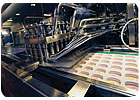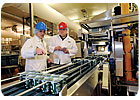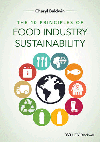
Sure, it’s big – one of the biggest of its type – but for a while, The Dannon Co.’s yogurt manufacturing plant in rural west-central Ohio appeared content to simply punch the clock each day.
“This plant had been sleeping a bit,” plant director Didier Menu explains. “For several years, there was minimal investment.”
Then Dannon launched Activia, and with it, a whole new way of eating yogurt. American consumers at last woke up to probiotics, and the Minster plant found itself hip-deep in the company’s push for greater capacity to meet the heightened demand. The plant now operates around the clock all year, except for a handful of holidays.
“This plant has always been the biggest one in North America,” says John St. Clair, the plant’s quality and food safety manager. “So as compared with [other Dannon North American plants], the bar for operational performance wasn’t very high. So while we always considered ourselves the best in the U.S., we didn’t compare well when benchmarked against some of the operational performance indicators of our sister plants throughout the world.”
Things have come a long way in the past two and a half years, and the Minster plant – acquired in 1968 from a local dairy operation owned by two brothers, and expanded considerably since – has become a crucial piece of Dannon’s manufacturing network that includes three facilities strategically located across the United States. Each plant makes most of Dannon’s top-selling products – including Activia, DanActive and Light & Fit – to more efficiently serve each region’s markets and maximize product shelf life.
More than 100 SKUs of various varieties, flavors and sizes are made in Minster; most are made at least once a week, some twice. The plant is the third largest in volume worldwide for Groupe Danone, Dannon’s French-based parent company.
“Through investment, we have renewed about one-third of the capacity of the plant while also increasing overall capacity,” says Menu, who came to the Minster plant in 2007. He credits a dedicated work force for helping the facility reach its full potential. “The changes are bringing benefits. It is of course always challenging, but the team here now believes in our continuous improvement program.”

Bottles and cups
The first of the new generation of improvements came in August 2005, when Minster began bottling Dannon’s DanActive probiotic beverage. Before then, this product was made only at the company’s plant in Fort Worth, Texas. A second bottle line was added about a year later.HDPE bottles are fed to these lines, which can also package Dannon’s Danimals drinkable smoothies for kids, by an overhead conveyor that transports the bottles from a blow-molding operation at the other end of the plant campus, where Graham Packaging leases and operates an on-site facility in a “through-the-wall” arrangement.
The bottles are lifted from a hopper and assured to be clean by blowing with sterile air. Then they’re set into platens in long rows and filled in a system from Ermi Agroalimentaire. The bottles are filled, then foil seals are applied and thermally attached.
St. Clair explains that the plant’s newer fillers like this one have no exposed lights or glass in filling area as a precaution against potential contamination. “We minimize glass and foreign objects,” he says.
But perhaps one of the most significant transitions at Minster is the ongoing move from preformed polypropylene cups to cups thermoformed on site from sheets of polystyrene. The plant now has at least three thermoformed PS cup lines, and the company expects to phase out the use of preformed cups as the equipment ages. “In 10 years, you’ll see the vast majority in FFS,” says Michael Neuwirth, Dannon’s senior director of public relations.
This arrangement has several advantages. St. Clair notes that each 1,000-pound roll of polystyrene lasts for several hours of production, freeing workers from the frequency and physical stress of loading stacks of cups into hoppers. Also from a production standpoint, thermoformed cups use in-mold labeling, conferring significant scheduling flexibility over preforms, which must be pre-labeled.
And at a time when green is the thing, thermoformed cups have two important environmental advantages: they have walls about 25% thinner than preformed ones, and significantly more PS rollstock fits into a delivery truck than empty preform cups. Further, the PS trimmings are recycled.
During DFR’s recent visit to Minster, 4-ounce cups of Activia were being filled on one of the thermoforming lines. A plastic sheet unrolls into a web that flows into the thermoform-fill-seal system from Arcil. The plastic web is heated and positioned over a grid of molds that have labels inserted into them, cut from a separate web. Plungers descend and push the heated plastic into the molds, forming blocks of cups that travel below a cluster of filler nozzles for filling at room temperature. Multiple flavors can be filled at once for variety packs. Once the cups are filled, lids are applied and heat-sealed, and the blocks of cups are cut into various-size units, which then receive a cardboard outer wrap.
Equipment that was purchased or revamped over the last five years now accounts for about a third of the plant’s present capacity, Menu says. And while the production floor has grown to accommodate about a dozen lines, technology has allowed output to advance even more significantly.
“When we upgrade lines, we increase production efficiency. You can increase production capacity with the same number of lines,” Neuwirth explains. “Footprint is less important.”

Cap-ital savings
Even though the preform lines may appear to be on their way out, they too have had their share of improvements. Dannon stopped using clear plastic overcaps for most of its products three years ago, saving about 3 million pounds of plastic a year and making the sealing process easier.Quart tubs of plain cup-set yogurt – what Neuwirth jokingly refers to as “the yogurt of old” – are filled in preformed PS containers on a system from Gasti. The tubs are blown clean with sterilized air, then enter a chamber with HEPA-filtered air and are hot-filled with cultured milk, sealed with foil lids and sent off for incubation and the transformative process that creates yogurt.
At the end packaging, conveyers have been replaced by automatic guided vehicles (AGVs) from HK Systems to take the pallets to the Lantech stretchwrappers, steered along the way by laser signals. The AGVs are part of a drive to refocus the manpower in Minster’s packaging lines to improve productivity. One recently installed line is on its way to one operator between the filler and the palletizer, and others could follow. Teamwork will be the key to doing that, Menu says: “To have one person per line, you need to have an operator like a race car driver. However, that operator needs a high-performance support team helping them.”
As an example, Menu says, operators under the old model have to cart packaging waste and recyclables to the bins themselves. The new line is serviced by a “waste and recycling train”-an electric cart toting a chain of small, wheeled bins, each one carrying a load of corrugate, plastic trimmings and other recyclables and waste.
Keeping the bins small has another environmental benefit. “When you reduce the size of the bin,” Menu quips, “people find a way to reduce the amount of waste.”
The Minster team is also tackling processing waste. The plant opened a new wastewater pretreatment facility last summer that cleans waste water before it’s discharged into the municipal sewer system. “Some of the waste we collect during dairy processing is kept separately in a tank and local farmers come and haul it away to feed it to their hogs,” Menu adds.
Moving the wastewater facility cleared space for a new utility building expected within two years, which in turn will free up space within the plant to reconfigure the production area.

It all starts with ...
Raw milk arrives at the Minster plant in up to 40 tankers per day, totaling upwards of 2 million pounds. Most of the milk comes from Dairy Farmers of America member farms located within 400 miles of the facility. The plant also received some condensed milk for certain products and ships out surplus cream.The milk receiving lab conducts antibiotic residue and other required standard tests that the milk must pass before being offloaded. Dannon also conducts other tests that are rotated periodically.
For blended products, milk is HTST pasteurized, then inoculated with cultures specifically designed for each of Dannon’s many products. Starter cultures are stored frozen in a special storage room. Once cultured, yogurt bases are stored in surge tanks until needed at the fillers, where fruits and flavors are mixed in as required. Tanks can be routed to any filler in the plant through a series of valve clusters.
Preprogrammed recipes are set in motion in the automated batching control room. Every vat has a production order number coded into the system that outlines each recipe, from the yogurt itself to packaging materials needed for each product, St. Clair explains. “It tells what materials to pick from the warehouse,” he says, noting that all materials are rounded up within 3 hours before each batch starts running. “We get them staged in time so the operator is ready to go. We try to get as long runs as possible for better efficiency.”
The Minster team is often involved with getting new products off the ground. St. Clair says Dannon’s R&D team, based in Fort Worth, Texas (Groupe Danone’s global R&D center is in France), develops concepts at its pilot plant. “Once they’re ready to try it on a huge scale, they’ll run it here in Ohio or at our Texas plant,” he says.
Safety, security, satisfaction
The Ohio Department of Agriculture makes quarterly inspections of equipment at the Minster plant, which – coupled with Dannon’s own aggressive internal audits – ensures a high degree of food safety. St. Clair says the key to food safety with dairy products is GMPs, hygiene, preventative maintenance and proper pasteurization. “I’ve been with Dannon 23 years and we’ve never compromised on food safety,” he says.Additionally, the plant has a HACCP-type program. “Our intention is to have a program that is certified by an independent third party,” St. Clair says.
Dannon also has a rigorous program to avoid the possibility of foreign objects in its products, Minster’s team says. Magnets and other methods are used to screen dry ingredients, supplementing the foreign object detection systems in place on each line. Furthermore, each cup of yogurt or drink bottle is coded to allow traceability back to each batch in the event of a recall.
“We are relatively safe from a lot of the bacterial food safety issues impacting the food industry at large because of the relatively low pH of our product and the regulated nature of dairy products,” Neuwirth says.
Employee safety, Menu says, is about “empowerment and involvement.” A year ago, Minster launched a new safety program that got more employees involved in the process. The result: 2007 had half of the recordable accidents as 2006, and in 2008 to date, there have been half of those in 2007.
Plant managers offer refresher courses on various safety aspects, and at monthly plant-wide meetings to review business and performance, “the first topic is always safety,” Menu says.
For operators on the production floor, the managerial formula at the Minster plant is QCDM: quality, cost, delivery and motivation. The plant ties these concepts to specific metrics and posts the results, for each line, in the plant’s hallways. Quality translates to the amount of product removed from each line per shift; cost, to production efficiency (actual production divided by maximum throughput).
Plant managers try to keep changeovers to a minimum. When packaging machinery needs to be adjusted-for instance, to change from four-packs to six-packs of 4-ounce cups, or to switch from single-layer to double-layer cases-it’s done with a combination of manual adjustments and servo controls. Menu says the changeover process has been streamlined to 8 minutes in some cases.
“The challenge was to get people involved with the new plan,” Menu says of the changes at Minster over the past two years. “I can [now] say I believe we are getting there. But if we had met six months ago, I would have said, ‘This is our plan, but I’m not quite sure.’ But people are starting to see that all these changes are bringing benefits. They are starting to believe in our plan and the results are showing.”
Pan Demetrakakes, executive editor of Food & Beverage Packaging, contributed to this article.
At A Glance
The Dannon Co.Location: Minster, Ohio
Year opened: 1968
Size: 336,000 square feet on nearly 30 acres.
Number of employees: 400
Products made: Spoonable and drinkable yogurts including Activia, DanActive, Light & Fit, All Natural and Danimals, totaling more than 100 SKUs.
Total processing capacity: Up to 2 million pounds per day.
Pasteurization: HTST and HHST
Number of filling lines: About a dozen, including form-fill-seal, preform and bottles.
Storage capacity: 1,500 pallets.
Extras
Dannon’s key suppliers include these companies:
Advanced Instruments
APV
Arcil
Aries Packaging
Berry Plastics
Breddo Likwifier
Cargill
Danisco
Ecolab
Ermi
Foss
Fristam
Gasti
GEA Tuchenhagen
Givaudan
HK Systems
Huhtamaki
International Flavors & Fragrances
Lantech
Mettler Toledo
Priority One
Thermo Electron Corp.
Remy
Westfalia Separator
Winpak
